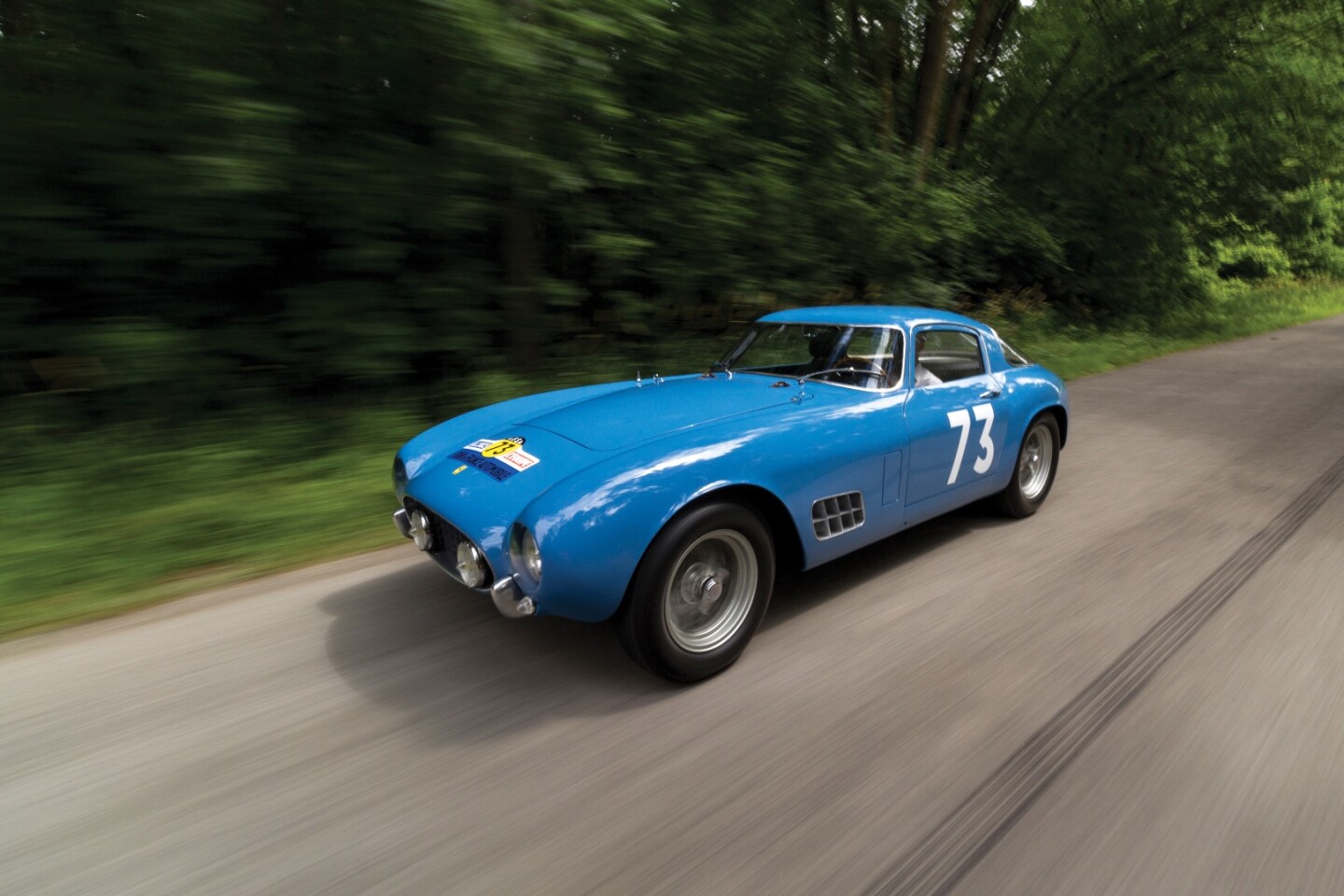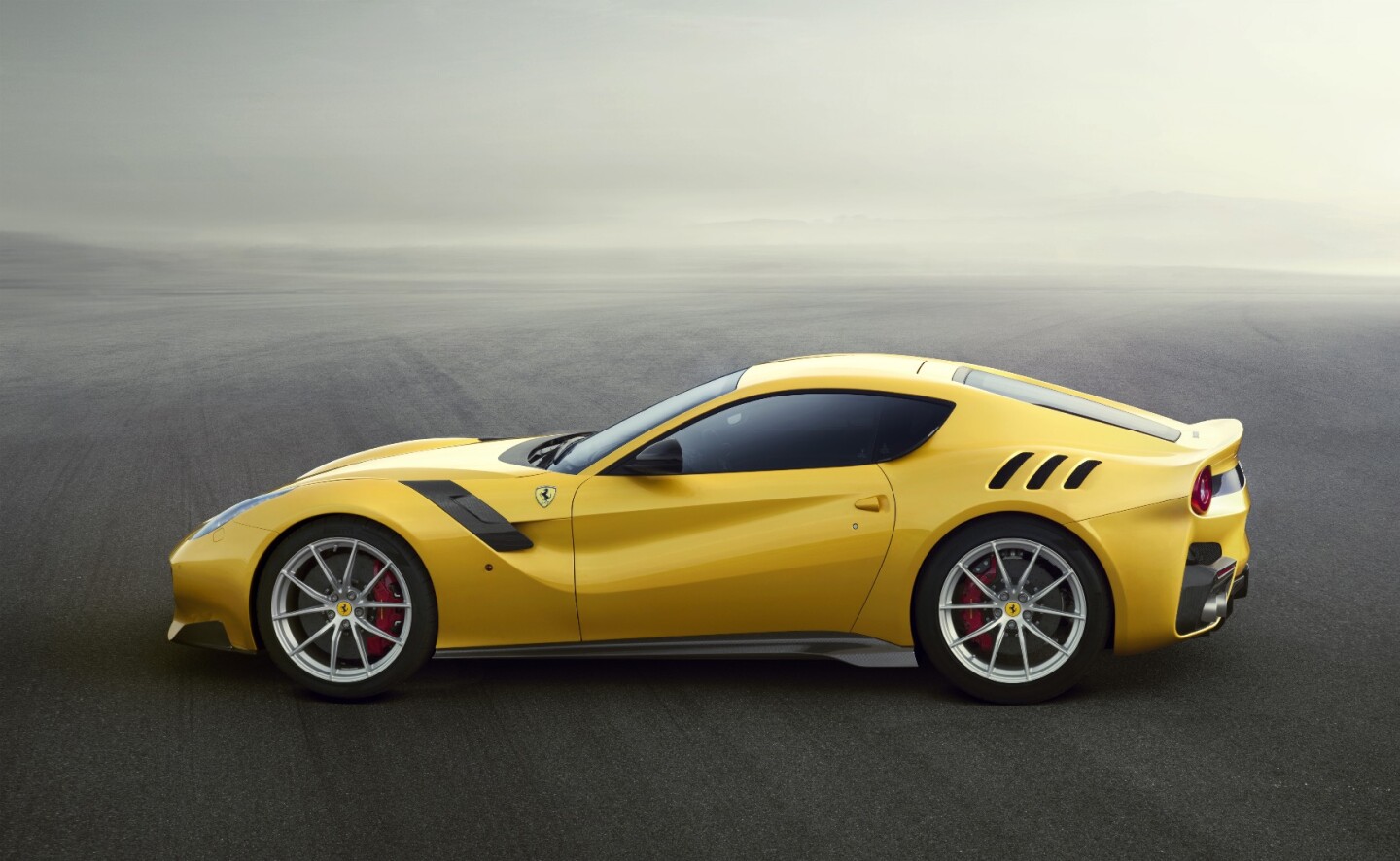The Ferrari F12 Berlinetta is already one of the most powerful naturally aspirated cars on the planet, but that doesn't mean there isn't room for improvement. The new F12tdf opens up the possibilities, carrying 40 extra angry horses under the hood and tearing through twists with help from a new rear-wheel steering system. This is an extreme F12 optimized for both road and track.
The newest Ferrari pulls its t, d and f from the Tour de France – not the skinny tire, Lance Armstrong PED-pumping bike race, but the classic auto race that Ferrari dominated back in the 1950s and 60s.
"It was a race that rewarded cars that combined maximum performance with the drivability and ease of use that enabled the competitors to race for hundreds of kilometers a day over fast, tortuous roads and on circuits," Ferrari says.
In developing the F12tdf, Ferrari relied on its experience with both racing and XX track car development to give its new car the same spirit of all-road drivability and track-lapping performance as classic Tour de France racers like the very first "tdf", the 1956 250 GT Berlinetta (pictured below), which sold at auction for more than US$13 million this past August.

Ferrari starts things off with a sizable power increase, tuning the F12's 6.3-liter V12 engine to 769 hp (573 kW), a bump up from 729 hp (544 kW). The engine remains naturally aspirated, making that lofty power figure all the more impressive. That peak power comes at 8,500 rpm, with the max torque of 520 lb-ft (705 Nm) at 6,750 rpm. The tweaked engine makes 80 percent of that torque available by 2,500 rpm, and Ferrari promises progressive pick-up straight through to the redline of 8,900 rpm.
The engine receives plenty of help when it comes to turning raw power into hammer-dropping straight lines and taut, athletic movement through the curvy sections. The F1-derived dual-clutch transmission boasts 6 percent shorter gear ratios for 30 percent faster upshifts and 40 percent faster downshifts. The front axle gains increased lateral acceleration from the new 275/35 ZR 20" 10" J front tires, which are set on widened tracks, along with the 315/35 ZR 20" 11.5" J rear tires.
To combat the oversteer the new front tires could otherwise cause, Ferrari premieres the Virtual Short Wheelbaserear-steering system, which is similar to the rear-wheel steering Porsche has been adding to various cars in its lineup. The VSW system relies on control logic to assess the vehicle speed, steering wheel angle and speed of steering input to precisely adjust the angle of the rear wheels for sharpened responsiveness, hastened turn-in and improved stability.
Ferrari only demonstrates the VSW system moving the rear wheels in the same direction as the fronts, which differs from Porsche's approach of moving them both with and against the front wheels, depending upon speed. Ferrari adds the system to ensure that the newest Prancing Horse can be effectively reined in and enjoyed by less experienced drivers - part of the whole "drivability for hundreds of kilometers a day" mentality.

To make improvements upon the "most aerodynamic series production Ferrari," Ferrari doctored the body to the tune of an 87 percent increase upon the F12's already heady downforce figure. The new kit includes an advanced, competition-inspired front bumper; GT racing-derived strakes on the underbody; a redesigned rear diffuser with active flaps; redesigned, bare-carbon Aerobridges on the front fenders; and air-shedding louvers over the rear wheels. The rear spoiler is 2.4 in (60 mm) longer and 1.2 in (30 mm) higher and is aided by reworked windscreen and trunk hatch geometry.Not only do those aerodynamic improvements help optimize airflow and give the F12tdf 507 lb (230 kg) of downforce at 124 mph (200 km/h), but they give it a look quite distinct from the standard F12. The front and rear ends, flank cuts and jutting rear spoiler are all quite different, and the widened stance helps to drive the new look home.
Inside, Ferrari has gone with a minimalistic, drive-focused design, showcasing bare carbon, Alcantara trim and raw aluminum floor panels. In place of the glove compartment, it's added knee padding.
Overall, the F12tdf weighs 243 pounds (110 kg) less than the F12, helping it to break the three-second mark in hitting 62 mph (100 km/h) in 2.9 seconds. That's two-tenths of a second faster than the standard Berlinetta, and the F12tdf loses an extra four-tenths of a second by the time it hits 124 mph (200 km/h) in 7.9 seconds. Top speed is over 211 mph (340 km/h).
With help from the Extreme Design single-piece calipers brought over from the LaFerrari, the F12tdf is also quick to decelerate, coming to a stop from 62 mph (100 km/h) in 100 feet (30.5 m) and from 124 mph (200 km/h) in 397 feet (121 m).
Ferrari plans to build 799 F12tdf examples but did not release pricing information in its announcement.
Take a quick, one-minute look at the F12tdf's rear-wheel steering in the video clip below.
Source: Ferrari











